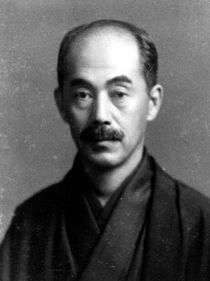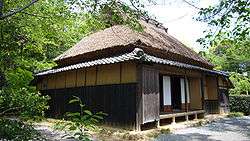Kunio Yanagita

Kunio Yanagita (柳田 國男 Yanagita Kunio, July 31, 1875 – August 8, 1962) was a Japanese scholar who is often known as the father of Japanese native folkloristics, or minzokugaku.
He was born in Fukusaki, Hyōgo Prefecture. After graduating with a degree in law from Tokyo Imperial University, he became employed as a bureaucrat in the Ministry of Agriculture and Commerce. In the course of his bureaucratic duties, Yanagita had the opportunity to travel throughout mainland Japan. During these business trips, Yanagita became increasingly interested in observing and recording details pertaining to local village customs. Under the influence of literary friends such as the writer Shimazaki Toson, Yanagita published works supposedly based on local oral traditions such as Tales of Tono (1912). He collaborated extensively with folklorist Kizen Sasaki, and they published several books together.
Yanagita's focus on local traditions was part of a larger effort to insert the lives of commoners into narratives of Japanese history. He argued that historical narratives were typically dominated by events pertaining to rulers and high-ranking officials. Yanagita claimed that these narratives focused on elite-centered historical events and ignored the relative uneventfulness and repetition that characterized the lives of ordinary Japanese people across history. He emphasized the unique practices of different groups of common people, such as sanka or mountain dwellers, and island dwellers. His work is frequently groundbreaking and sometimes has unique cultural records.
Major works

- Tōno Monogatari (遠野物語)
- a record of folk legends (as opposed to a folk tale) gathered in Tono, Iwate Prefecture. Famous yōkai in the stories include kappa and zashiki-warashi.[1]
- Kagyūkō (蝸牛考)
- Yanagita revealed that the distribution of dialects for the word snail forms concentric circles on the Japanese archipelago.
- Momotarō no Tanjō (桃太郎の誕生)
- He depicted some facets of Japanese society by analyzing the famous folk tale Momotaro. His methodology was followed by many ethnologists and anthropologists.
- Kaijō no Michi (海上の道)
- He sought the origin of the Japanese culture in Okinawa, though many of his speculations were denied by later researchers. He was inspired by picking up a palm nut borne by the Kuroshio Current when he was wandering on a beach in Iragomisaki, Aichi Prefecture.
See also
- Center versus periphery: Yanagita's theory about dialectal diffusion and vocabulary propagation over time
- Nihonjinron
Notes
References
| Wikimedia Commons has media related to Yanagita Kunio. |
- Mori, Kōichi (1980), "Yanagita Kunio: An Interpretive Study", Japanese Journal of Religious Studies 7/2–3: pp. 83–115. Retrieved May 29, 2014.
